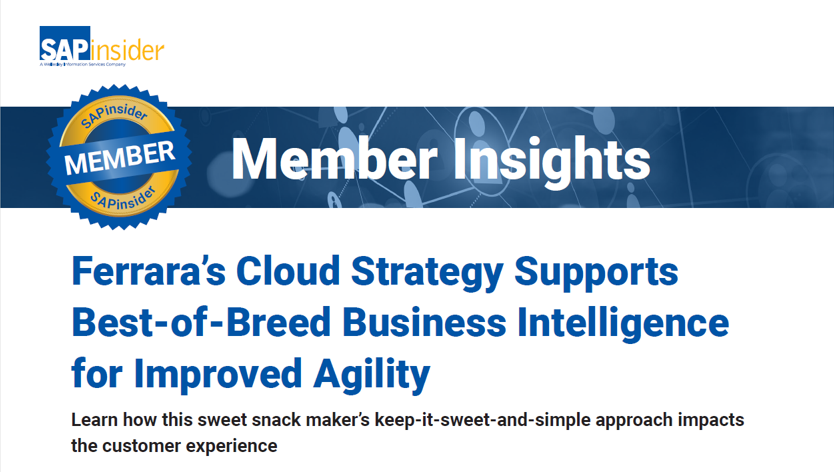A key aspect that consistently emerged in 2021, in multiple SAPinsider research reports about data and analytics, was that SAPinsiders believe that while the market has many different analytics tools and solutions to choose from, they still feel there is a void in terms of the kind of available analytics tools vs. the tools that they desire. Due to a lack of certain essential features in legacy business intelligence (BI) tools, this void has driven a need for an evolution of BI tools. Among many paths that the evolution of BI tools is taking, decision intelligence is a prominent trend. SAPinsider recently invited Dave Henry, Senior VP of Strategic Alliances from Pyramid Analytics, a leading decision intelligence platform in the SAP technology landscape, to discuss this critical topic. You can watch the full video of the discussion
here.
What is Decision Intelligence?
Behind all the innovative features and functionalities of business intelligence and analytics tools is one critical need: to leverage the power of analytics
across the enterprise. This is one of the critical requirements that users have when thinking about enterprise analytics. And for this to happen, a tool must be “fluid” in many senses. Not only should it encompass analytics across business functions, but it should also have the flexibility to be used by users with varying levels of skill. An analytics tool needs to be a powerful aid in decision-making to create a truly data-driven enterprise. For this to happen, it needs to be leveraged by users with all levels of expertise to make data-driven decisions in their day-to-day work. This is where the genesis of the term decision intelligence comes from.
As Dave highlighted: “From the Pyramid perspective, decision intelligence is about breadth. It's about helping all individuals in an organization optimize decision-making. It should support interactive self-service; it should be embedded in operational contexts. But it really combines the best of traditional enterprise analytic platforms with a more modern approach. The goal is ultimately to help people use all relevant data to make better decisions, achieve faster outcomes, troubleshoot problems, and capitalize on opportunities to drive innovation.”
Pyramid Analytics and Decision Intelligence
Pyramid offers an analytics platform that merges critical elements such as data preparation, business analytics, and data science in one unified environment. What makes this platform comprehensive and places it in the category of decision intelligence is that it covers the entire analytics pipeline and has enabling features like self-service data discovery and collaboration, allowing users of all skill levels to work independently and as teams.
Dave provides more context on why Pyramid considers itself a true decision intelligence platform when he provides Pyramid’s perspective of the definition of decision intelligence: “In our perspective, decision intelligence is a fusion of data preparation, self-service analytics, and artificial intelligence that's embedded inside the product to simplify and automate the process of doing complex analysis.”
The Role of Decision Intelligence in the SAP Landscape
SAP ERP users will agree that there is no better or more comprehensive ERP system. SAP S/4HANA are significant investments. When organizations commit to an ERP vendor, they are looking for ways to maximize the value of their investment over years, even decades. They are actively looking for solutions that can help them leverage the immense value of data in S/4HANA with other data sources. This is what Dave refers to as the “SAP+ challenge” that SAP customers face. And decision intelligence platforms are one such “sweet spot” that can help customers address this challenge. Dave highlighted this: “We see this desire for comprehensive analytics using data from multiple systems. We help with that while also improving their everyday use of SAP. Through Pyramid, we can bring what we feel is a world-class experience to SAP while extending this experience to modern cloud data warehouses such as Redshift and Snowflake.”
A capable decision intelligence platform is not just about business intelligence. And that is why platforms like Pyramid Analytics help extract maximum value from SAP investments. Platforms can help act as a “single source of truth” by tapping into disparate data sources and enhancing collaboration, building a data-driven culture. And as the analytics landscape evolves and customers embrace advanced AI and ML algorithms, these platforms can play a role there.
Dave summarizes this succinctly: “Customers want to access the power of BW and HANA directly; they don't want to extract data. But at the same time, they need to integrate external data sources and leverage machine learning. They want to use the unlimited scalability of public clouds. This typically drives them to adopt a data lake strategy that complements their SAP landscape. We see this consistently across all industries. They really want a universal experience—their analytics experience—to be seamless and collaborative regardless of the underlying data. They want the power to use SAP environments and the modern data stack. This is the “SAP+” challenge they're coming to us to solve.”
What Does This Mean for SAPinsiders?
Decision intelligence solutions seem to answer the challenges that SAPinsiders have long identified with legacy BI solutions. However, as SAPinsiders embark on their journey to build decision intelligence capabilities, there are certain vital aspects that they need to keep in perspective:
- Evaluate your current state. A critical first step in any technology transformation journey is to understand the bottlenecks and challenges with the current state. Before you embark on developing decision intelligence capabilities, take time to understand your current bottlenecks and challenges.
- Integration capabilities are critical. Integration is one of the essential aspects of any analytics solution, so it is crucial to understand what type of integration capabilities a solution provides. Integration needs to be two-pronged. On the one hand, it needs to complement other business applications, and on the other hand, it should be able to integrate seamlessly with varied data sources.
- Leverage the power of advanced analytics. A robust decision intelligence tool should be able to perform analytics leveraging advanced analytics algorithms yet allow non-technical users to use the tool. In order to make the best use of the tool, educate the end-users on how they can leverage these advanced analytics methodologies.






